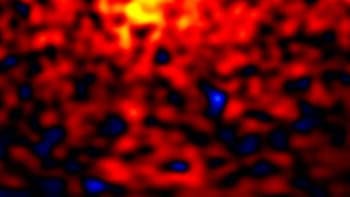
A new study of the rotational velocities of stars in galaxies has revealed a strong correlation between the motion of the stars and the amount of visible mass in the galaxies. This result comes as a surprise because it is not predicted by conventional models of dark matter.
Stars on the outskirts of rotating galaxies orbit just as fast as those nearer the centre. This appears to be in violation of Newton’s laws, which predict that these outer stars would be flung away from their galaxies. The extra gravitational glue provided by dark matter is the conventional explanation for why these galaxies stay together. Today, our most cherished models of galaxy formation and cosmology rely entirely on the presence of dark matter, even though the substance has never been detected directly.
These new findings, from Stacy McGaugh and Federico Lelli of Case Western Reserve University, and James Schombert of the University of Oregon, threaten to shake things up. They measured the gravitational acceleration of stars in 153 galaxies with varying sizes, rotations and brightness, and found that the measured accelerations can be expressed as a relatively simple function of the visible matter within the galaxies. Such a correlation does not emerge from conventional dark-matter models.
Mass and light
This correlation relies strongly on the calculation of the mass-to-light ratio of the galaxies, from which the distribution of their visible mass and gravity is then determined. McGaugh attempted this measurement in 2002 using visible light data. However, these results were skewed by hot, massive stars that are millions of times more luminous than the Sun. This latest study is based on near-infrared data from the Spitzer Space Telescope. Since near-infrared light is emitted by the more common low-mass stars and red giants, it is a more accurate tracer for the overall stellar mass of a galaxy. Meanwhile, the mass of neutral hydrogen gas in the galaxies was provided by 21 cm radio-wavelength observations.
McGaugh told physicsworld.com that the team was “amazed by what we saw when Federico Lelli plotted the data.”
The result is confounding because galaxies are supposedly ensconced within dense haloes of dark matter. Furthermore, the team found a systematic deviation from Newtonian predictions, implying that there is some other force is at work beyond simple Newtonian gravity.
It’s an impressive demonstration of something, but I don’t know what that something is
James Binney, University of Oxford
“It’s an impressive demonstration of something, but I don’t know what that something is,” admits James Binney, a theoretical physicist at the University of Oxford, who was not involved in the study.
This systematic deviation from Newtonian mechanics was predicted more than 30 years ago by an alternate theory of gravity known as modified Newtonian dynamics (MOND). According to MOND’s inventor, Mordehai Milgrom of the Weizmann Institute in Israel, dark matter does not exist, and instead its effects can be explained by modifying how Newton’s laws of gravity operate over large distances.
“This was predicted in the very first MOND paper of 1983,” says Milgrom. “The MOND prediction is exactly what McGaugh has found, to a tee.”
However, Milgrom is unhappy that McGaugh hasn’t outright attributed his results to MOND, and suggests that there’s nothing intrinsically new in this latest study. “The data here are much better, which is very important, but this is really the only conceptual novelty in the paper,” says Milgrom.
No tweaking required
McGaugh disagrees with Milgrom’s assessment, saying that previous results had incorporated assumptions that tweak the data to get the desired result for MOND, whereas this time the mass-to-light ratio is accurate enough that no tweaking is required.
Furthermore, McGaugh says he is “trying to be open-minded”, by pointing out that exotic forms of dark matter like superfluid dark matter or even complex galactic dynamics could be consistent with the data. However, he also feels that there is implicit bias against MOND among members of the astronomical community.
“I have experienced time and again people dismissing the data because they think MOND is wrong, so I am very consciously drawing a red line between the theory and the data.”
Much of our current understanding of cosmology relies on cold dark matter, so could the result threaten our models of galaxy formation and large-scale structure in the universe? McGaugh thinks it could, but not everyone agrees.
Way too complex
Binney points out that dark-matter simulations struggle on the scale of individual galaxies because “the physics of galaxy formation is way too complex to compute properly,” he says, the implication being that it is currently impossible to say whether dark matter can explain these results or not. “It’s unfortunately beyond the powers of humankind at the moment to know.”
That leaves the battle between dark matter and alternate models of gravitation at an impasse. However, Binney points out that dark matter has an advantage because it can also be studied through observations of galaxy mergers and collisions between galaxy clusters. Also, there are many experiments that are currently searching for evidence of dark-matter particles.
McGaugh’s next step is to extend the study to elliptical and dwarf spheroidal galaxies, as well as to galaxies at greater distances from the Milky Way.
The research is to be published in Physical Review Letters and a preprint is available on arXiv.



